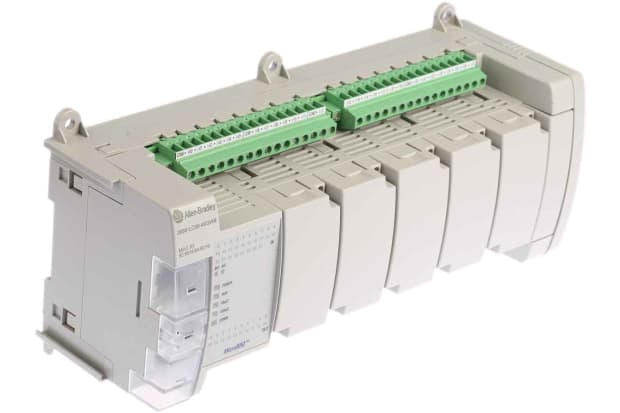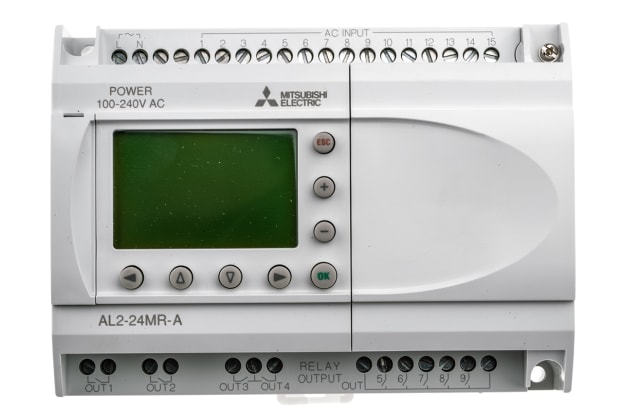- Published 17 Jan 2023
- Last Modified 5 Apr 2024
- 8 min
PLCs - A Complete Guide
Our guide introduces you to the various systems and gives you tips on how to select a PLC and the right accessories

What are PLCs?
Programmable Logic Controllers (PLCs) are designed to monitor and regulate machines and manufacturing processes in industrial environments with automation technology. They can function as autonomous systems, optimising processes intelligently and independently.
So, what is a PLC? Essentially, a PLC is a digitally operating electronic system that is equipped with programmable memory. This non-volatile memory is used to save control instructions that enable the device to perform certain functions and exercises. Various types of machines and processes are then controlled via digital and analogue inputs and output modules.
PLC Applications
Thanks to their great flexibility, programmable logic controllers are being used more and more frequently in many areas of industry. These industrial computing solutions were originally intended to replace electromechanical relay systems, and this is still the case in some instances.
Uses of PLCs can vary between applications and professional vs domestic environments. Process automation PLC tasks are commonplace in industry both in the UK and across the world. These components are widely used in manufacturing, food and beverage, and building control.
What does a PLC do? Typical examples of PLC uses include:
- Production plants
- Traffic light controls
- Packaging machines
- Lifts and escalators
- Medical applications
- Automatic gate systems
- Heating control systems
How Do PLCs Work?

A PLC controller primarily has inputs and outputs. Essentially, they are networkable devices that are programmed to respond to inputs and give certain outputs. Programmable logic controllers can also include human-machine interfaces.
These electronic components are digitally programmable and can take on complex control tasks in networked production processes in Industry 4.0.
The relationship between hardware, software and programming is explained in greater detail in the following sections of this guide.
PLC Programming
Different models are suitable for use with varying programming languages. Common options include:
- ST: Structured Text (text-based)
- FBD: Function Block Diagram (graphic-based)
- LAD: Ladder logic (graphic-based)
- STL: Statement List (text-based)
- SCL: Structured Control Language (graphic-based)
PLC programming courses and tutorials are widely available if you are new to the world of logic and programming languages. FBD is a popular choice for beginners as it utilises a drag-and-drop functionality. Additionally, it helps to make I/O behaviour easy to understand. Visual, image-based languages such as Ladder logic can also help when it comes to understanding and improving processes. For instance, a simple, user-friendly Ladder diagram can be a big help. On the flip side, SCL is primarily used for more complex and demanding programming requirements.
It is also important to note that although you would normally use a laptop and software, some older models can be used with handheld programmers.
PLC Software
The control is programmed via the application program either on the computer or via a connected control panel. It is loaded onto the controller via the interface and defines the switching of output devices and input devices. The actual operation is then handled by the PLC, independently of the personal computer, and autonomously as the controllers have their own power supply.
Specific functions of PLCs include:
- Flow control
- Link control
- Number-based functions including time and counting
Programmable logic controller software can be further categorised as follows:
- Cycle-oriented PLCs - these follow the basic principle of data processing with input, processing, and output. The inputs are queried, and control is passed onto the user program. The process will start all over again after the control signals have been transferred to the outputs
- Cyclic PLCs with interrupt - these are programmed to run an additional program loop adapted to a different situation if the status of the connected sensor changes. The main program will then continue once the additional loop has completed
- Event-controlled PLCs - these are designed to process specific pre-programmed tasks following a status change of the connected sensor/s
It should be noted that PLC programming software is not standardised. It will be specific to a manufacturer and sometimes a specific model, too. This might also mean that different alternatives to common serial cables may be used when determining the requirements for PLC accessories.
PLC Hardware
A PLC device essentially consists of a base station with some inputs and outputs. The basic version features a processor in the central assembly, signal inputs and outputs, the interface, and an operating system.
Depending on the model’s complexity, controllers may have a different number of analogue or digital inputs and outputs. These are linked to the system or machine via sensors and actuators. For instance, at the inputs, sensors such as temperature, level, or pressure sensors monitor the machine functions. The operating system will then evaluate the collected information and compare it with programmed user-defined parameters before sending the corresponding control signals to the outputs.
The actuators that regulate the functions can also vary. They can be:
- Electric valves - used with hydraulics and compressed air
- Contactors - used for switching electric motors
- Drive control modules
As well as this, one of the greatest advantages of PLCs is their cross-system networking capabilities with other computers and devices. Even older models can be connected to new devices using the appropriate cables, plugs, and adapters.
Most controllers can be connected to a computer using a serial cable. Serial device servers are suitable for this, and conventional serial components can also be connected via LAN. Ethernet media converters are also used to ensure compatibility and connect different transmission media. Common interfaces are RS-232 and RS-485 with DB-9 and DB-25 connectors.
A programmable logic controller will become more efficient with the right additional equipment and can be expanded with devices via the interface. It is also possible to include additional add-on modules with extra I/O if needed. Further PLC hardware components include:
What's Inside a PLC?
Design smarter and discover the core components inside a modern, complex programmable controller. From serial ports and digital input modules to wire-to-board connectors, memory, and passives, these components combine to create high-performance, industry-leading programmable logic controllers.
Watch our handy video to see these systems brought to life and understand how each component works together to control IoT, automation, and industrial manufacturing processes.
PLC Examples
A wide range of PLC controllers are available, each best suited to different purposes and applications. In the broadest terms, the choice is between:
Small, low I/O models
Large, modular systems
Types of PLC
Programmable logic controllers can be classified in multiple different ways. There are many different types, each with unique functions, features, and capabilities.
Concerning structure and functionality, a clear distinction can be made between hard and soft PLCs. Classic - or hard PLCs - are hardware-based. They are general-purpose and typically only include the most important control functions although extensions can be added for DIN rails and plug-in connections, for example.
On the other hand, soft programmable logic controllers are focused on control via software. They have their own operating system and often other user software as well. However, they do not have their own central processing unit (CPU) so use the PC processor instead. As this means that they must share the processor with the PC's operating system (and possibly other applications), this can affect performance when the workload is high.
Additional types include compact and slot PLCs. In a compact PLC, all the components are on a single circuit board in one housing. A slot controller is used directly as a PCI plug-in card, intended for specific tasks such as storing production data. With these controls, the digital computer is designed to replace the PLC hardware. However, in contrast to a soft PLC, slot types feature a co-processor and their own operating system. This enables them to perform control tasks independently of the PC processor. Integrated connections provide access to decentralised sensors and actuators.
Type | Features |
|---|---|
Hard PLC | - PLC hardware solution featuring the most important functions - Functions can be expanded if necessary - Quick start time - Good real-time behaviour |
Soft PLC | - PLC software solution - Easy-to-use - Slow start-up - Can become unstable with higher loads |
Compact PLC | - Space-saving design - Cost-effective - Ideal for small-scale tasks |
Slot PLC | - Compact in size - Includes own built-in power supply - Provides simplified communication between controller and PC |
PLC Manufacturers
Leading PLC control panel manufacturers include:
Siemens
With a wide range of high-quality PLCs available, choose leading brand Siemens for your product requirements.
Allen Bradley
Offering different sizes, features, and modules, browse our full range of Allen Bradley PLCs today.
Mitsubishi
We stock an extensive selection of leading Mitsubishi programmable logic controllers. Shop online with RS.
Omron
Renowned for high-quality, high-performance products, shop the full range of Omron PLCs with RS.



